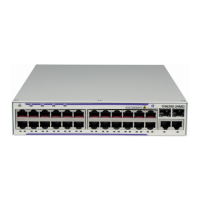VPLS Features
Page 252 7210 SAS M Services Guide
VPLS over MPLS in Network Mode
The VPLS architecture proposed in draft-ietf-ppvpn-vpls-ldp-0x.txt specifies the use of provider
equipment (PE) that is capable of learning, bridging, and replication on a per-VPLS basis. The PE
routers that participate in the service are connected using MPLS Label Switched Path (LSP)
tunnels in a full-mesh composed of mesh SDPs or based on an LSP hierarchy (Hierarchical VPLS
(H-VPLS)) composed of mesh SDPs and spoke SDPs. The 7210 SAS M supports only H-VPLS.
Multiple VPLS services can be offered over the same set of LSP tunnels. Signaling specified in
RFC 4905 is used to negotiate a set of ingress and egress VC labels on a per-service basis. The
VC labels are used by the PE routers for de-multiplexing traffic arriving from different VPLS
services over the same set of LSP tunnels.
VPLS/HVPLS is provided over MPLS by:
• Connecting 7210 SAS M to bridging-capable provider edge (PE) routers through a mesh/
spoke SDP. The PE routers are connected using a full mesh of LSPs.
• Negotiating per-service VC labels using draft-Martini encapsulation.
• Replicating unknown and broadcast traffic in a service domain.
• Enabling MAC learning over tunnel and access ports (see VPLS MAC Learning and
Packet Forwarding on page 254).
• Using a separate forwarding information base (FIB) per VPLS service.

